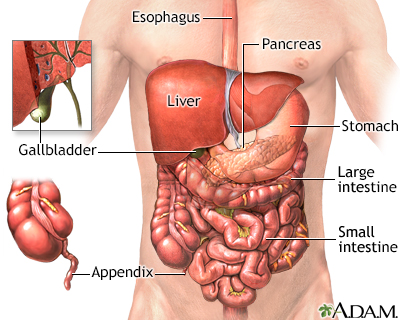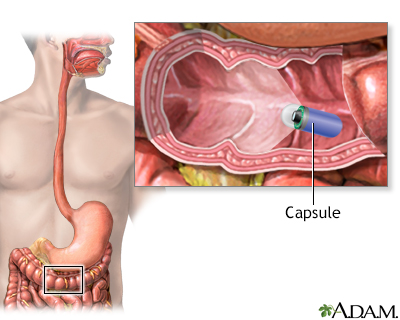Black or tarry stools
Black or tarry stools with a foul smell are a sign of a problem in the upper digestive tract. It most often indicates that there is bleeding in the esophagus, stomach, or first part of the small intestine.
The term melena is used to describe this finding.
Considerations
Eating black licorice, blueberries, blood sausage or taking iron pills, activated charcoal, or medicines that contain bismuth (such as Pepto-Bismol), can also cause black stools. Beets and foods with red coloring can sometimes make stools appear reddish. In all these cases, your health care provider can test the stool with a chemical to check for the presence of blood.
Bleeding in the esophagus or stomach (such as with peptic ulcer disease) can also cause you to vomit blood.
Causes
The color of the blood in the stools can indicate the source of bleeding.
- Black or tarry stools may be due to bleeding in the upper part of the GI (gastrointestinal) tract, such as the esophagus, stomach, or the first part of the small intestine. In this case, blood is darker because it gets digested on its way through the GI tract.
- Red or fresh blood in the stools (rectal bleeding), most often is a sign of bleeding from the lower GI tract (colon, rectum, or anus).
Rectal bleeding
Rectal bleeding is when blood passes from the rectum or anus. Bleeding may be noted on the stool or be seen as blood on toilet paper or in the toile...
 ImageRead Article Now Book Mark Article
ImageRead Article Now Book Mark Article

Abdominal organs
The process of digesting food is accomplished by many organs in the body. Food is pushed by the esophagus into the stomach. The stomach mixes the food and begins the breakdown of proteins. The stomach propels the food then into the small intestine. The small intestine further digests food and begins the absorption of nutrients. Secretions from the pancreas in the small intestine help neutralize the acid in the intestine to provide a proper environment for the enzymes to function. Bile from the gallbladder and liver emulsify fat and enhance the absorption of fatty acids. The large intestine temporarily stores and concentrates the remainder until it is passed out as waste from the body.
Peptic ulcers are the most common cause of acute upper GI bleeding. Black and tarry stools may also occur due to:
Peptic ulcers
A peptic ulcer is an open sore or raw area in the lining of the stomach or intestine. There are two types of peptic ulcers:Gastric ulcer -- occurs in...

- Abnormal blood vessels in the esophagus, stomach, or duodenum
- A tear in the esophagus from violent vomiting (Mallory-Weiss tear)
Mallory-Weiss tear
A Mallory-Weiss tear occurs in the mucous membrane of the lower part of the esophagus or upper part of the stomach, near where they join. The tear m...
 ImageRead Article Now Book Mark Article
ImageRead Article Now Book Mark Article - Blood supply being cut off to part of the intestines
- Inflammation of the stomach lining (gastritis)
Gastritis
Gastritis occurs when the lining of the stomach becomes inflamed or swollen. Gastritis may last for only a short time (acute gastritis) or it may lin...
 ImageRead Article Now Book Mark Article
ImageRead Article Now Book Mark Article - Trauma or foreign body
- Widened, overgrown veins (called varices) in the esophagus and stomach, commonly caused by liver cirrhosis
Varices
The esophagus (food pipe) is the tube that connects your throat to your stomach. Varices are enlarged veins that may be found in the esophagus in pe...
 ImageRead Article Now Book Mark Article
ImageRead Article Now Book Mark ArticleLiver cirrhosis
Cirrhosis is scarring of the liver and poor liver function. It is the last stage of chronic liver disease.
 ImageRead Article Now Book Mark Article
ImageRead Article Now Book Mark Article - Cancer of the esophagus, stomach, duodenum, or ampulla of Vater

Ulcer emergencies
Peptic ulcers may lead to emergency situations. Severe abdominal pain with or without evidence of bleeding may indicate a perforation of the ulcer through the stomach or duodenum. Vomiting of a substance that resembles coffee grounds, or the presence of black tarry stools, may indicate serious bleeding.
When to Contact a Medical Professional
Contact your health care provider right away if:
- You notice blood or changes in the color of your stool
- You vomit blood
Vomit blood
Vomiting blood is regurgitating (throwing up) contents of the stomach that contains blood. Vomited blood may appear bright red, dark red, or look lik...
Read Article Now Book Mark Article - You feel dizzy or lightheaded
Dizzy
Dizziness is a term that is often used to describe 2 different symptoms: lightheadedness and vertigo. Lightheadedness is a feeling that you might fai...
 ImageRead Article Now Book Mark Article
ImageRead Article Now Book Mark Article
In children, a small amount of blood in the stool is most often not serious. The most common cause is constipation. You should still tell your child's provider if you notice this problem.
What to Expect at Your Office Visit
Your provider will take a medical history and perform a physical exam. The exam will focus on your abdomen.
You may be asked the following questions:
- Are you taking blood thinners, or anti-platelet medicines, such as aspirin, warfarin, Eliquis, Pradaxa, Xarelto, or clopidogrel, or similar medicines? Are you taking an NSAID, such as ibuprofen or naproxen?
- Have you had any trauma or swallowed a foreign object accidentally?
- Have you eaten black licorice, iron, Pepto-Bismol, or blueberries?
- Have you had more than one episode of blood in your stool? Is every stool this way?
- Have you lost any weight recently?
- Is there blood on the toilet paper only?
- What color is the stool?
- When did the problem develop?
- What other symptoms are present (abdominal pain, vomiting blood, bloating, excessive gas, diarrhea, or fever)?
Abdominal pain
Abdominal pain is pain that you feel anywhere between your chest and groin. This is often referred to as the stomach region or belly.
 ImageRead Article Now Book Mark Article
ImageRead Article Now Book Mark ArticleBloating
Abdominal bloating is a condition in which the belly (abdomen) feels full and tight. Your belly may look swollen (distended).
 ImageRead Article Now Book Mark Article
ImageRead Article Now Book Mark ArticleExcessive gas
Gas is air in the intestine that is passed through the rectum. Air that moves from the digestive tract through the mouth is called belching. Gas is ...
 ImageRead Article Now Book Mark Article
ImageRead Article Now Book Mark ArticleFever
Fever is the temporary increase in the body's temperature in response to a disease or illness. A child has a fever when the temperature is at or abov...
 ImageRead Article Now Book Mark Article
ImageRead Article Now Book Mark Article
You may need to have one or more tests to look for the cause:
- Angiography
Angiography
An arteriogram is an imaging test that uses x-rays and a special dye to see inside the arteries. It can be used to view arteries in the heart, brain...
 ImageRead Article Now Book Mark Article
ImageRead Article Now Book Mark Article - CT or MRI angiography
- Bleeding scan (nuclear medicine)
Bleeding scan
An RBC nuclear scan uses small amounts of radioactive material (radioisotope) to mark (tag) red blood cells (RBCs). Your body is then scanned to see...
Read Article Now Book Mark Article - Blood studies, including a complete blood count (CBC) and differential, serum chemistries, clotting studies
Complete blood count
A complete blood count (CBC) test measures the following:The number of white blood cells (WBC count)The number of red blood cells (RBC count)The numb...
 ImageRead Article Now Book Mark Article
ImageRead Article Now Book Mark ArticleDifferential
The blood differential test measures the percentage of each type of white blood cell (WBC) that you have in your blood. It also reveals if there are...
 ImageRead Article Now Book Mark Article
ImageRead Article Now Book Mark ArticleSerum chemistries
Electrolytes are minerals in your blood and other body fluids that carry an electric charge. Electrolytes affect how your body functions in many ways...
Read Article Now Book Mark Article - Colonoscopy
Colonoscopy
A colonoscopy is an exam that views the inside of the colon (large intestine) and rectum, using a tool called a colonoscope. The colonoscope has a sm...
 ImageRead Article Now Book Mark Article
ImageRead Article Now Book Mark Article - Esophagogastroduodenoscopy or EGD
Esophagogastroduodenoscopy
Esophagogastroduodenoscopy (EGD) is a test to examine the lining of the esophagus, stomach, and first part of the small intestine (the duodenum)....
 ImageRead Article Now Book Mark Article
ImageRead Article Now Book Mark Article - Stool culture or multiplex PCR test of stool to test for infection
Stool culture
A fecal culture is a lab test to find organisms in the stool (feces) that can cause gastrointestinal symptoms and disease.
 ImageRead Article Now Book Mark Article
ImageRead Article Now Book Mark Article - Tests for the presence of Helicobacter pylori infection
Tests
Helicobacter pylori (H pylori) is the bacteria (germ) responsible for most stomach (gastric) and duodenal ulcers and many cases of stomach inflammati...
 ImageRead Article Now Book Mark Article
ImageRead Article Now Book Mark Article - Capsule endoscopy (a pill with a built in camera that takes a video of the small intestine)
Capsule endoscopy
Endoscopy is a way of looking inside the body. Endoscopy is often done with a tube put into the body that the doctor can use to look inside. Anothe...
 ImageRead Article Now Book Mark Article
ImageRead Article Now Book Mark Article - Double balloon enteroscopy (a scope that can reach the parts of the small intestine that are not able to be reached with EGD or colonoscopy)
Severe cases of bleeding that cause excessive blood loss and a drop in blood pressure may require surgery or hospitalization.
Reviewed By
Jenifer K. Lehrer, MD, Department of Gastroenterology, Aria - Jefferson Health Torresdale, Jefferson Digestive Diseases Network, Philadelphia, PA. Review provided by VeriMed Healthcare Network. Also reviewed by David C. Dugdale, MD, Medical Director, Brenda Conaway, Editorial Director, and the A.D.A.M. Editorial team.
DeGeorge LM, Nable JV. Gastrointestinal bleeding. In: Walls RM, ed. Rosen's Emergency Medicine: Concepts and Clinical Practice. 10th ed. Philadelphia, PA: Elsevier; 2023:chap 26.
Kovacs TO, Jensen DM. Gastrointestinal hemorrhage. In: Goldman L, Cooney KA, eds. Goldman-Cecil Medicine. 27th ed. Philadelphia, PA: Elsevier; 2024:chap 121.
Savides TJ, Jensen DM. Gastrointestinal bleeding. In: Feldman M, Friedman LS, Brandt LJ, eds. Sleisenger and Fordtran's Gastrointestinal and Liver Disease. 11th ed. Philadelphia, PA: Elsevier; 2021:chap 20.



 All rights reserved.
All rights reserved.